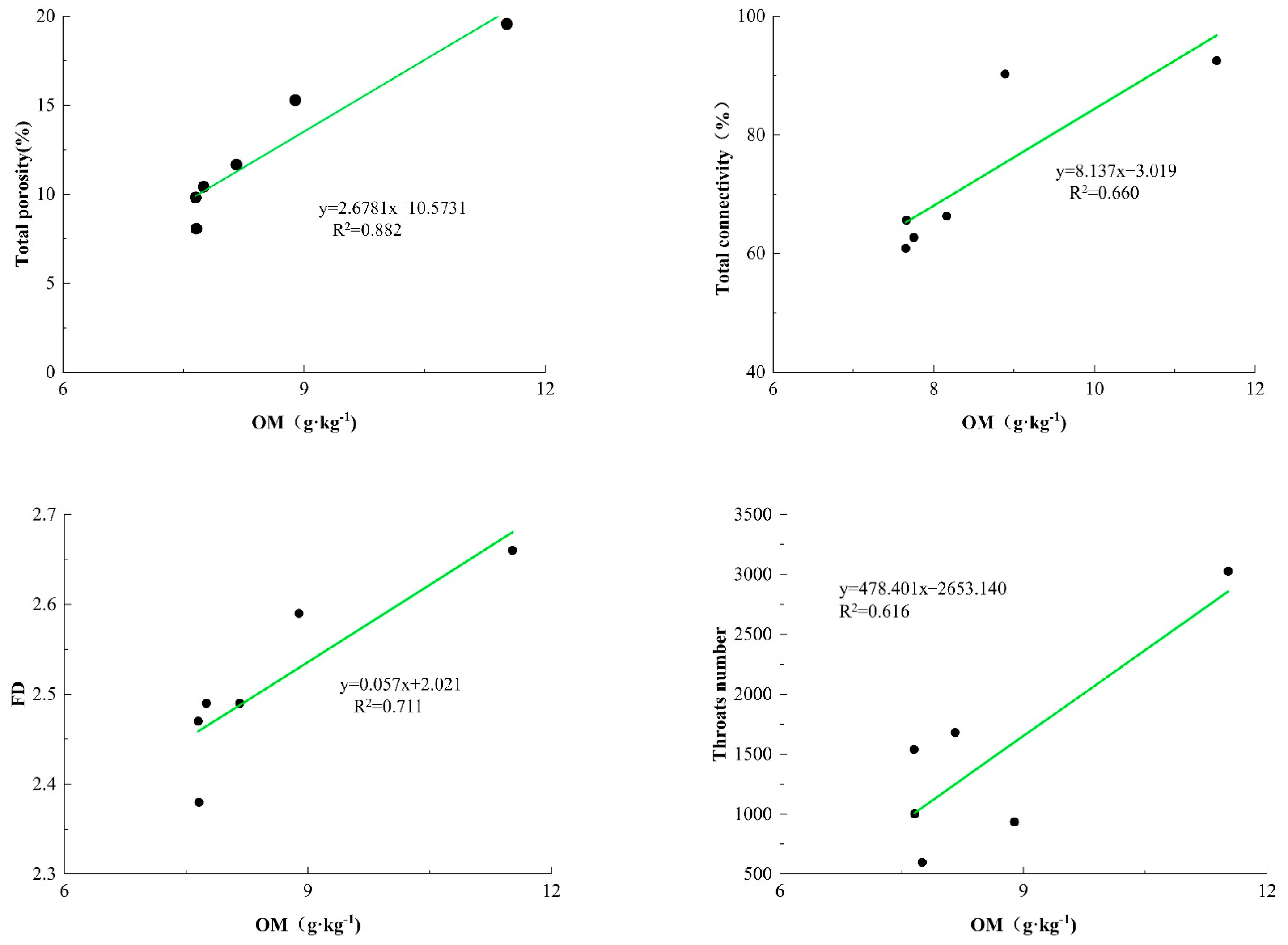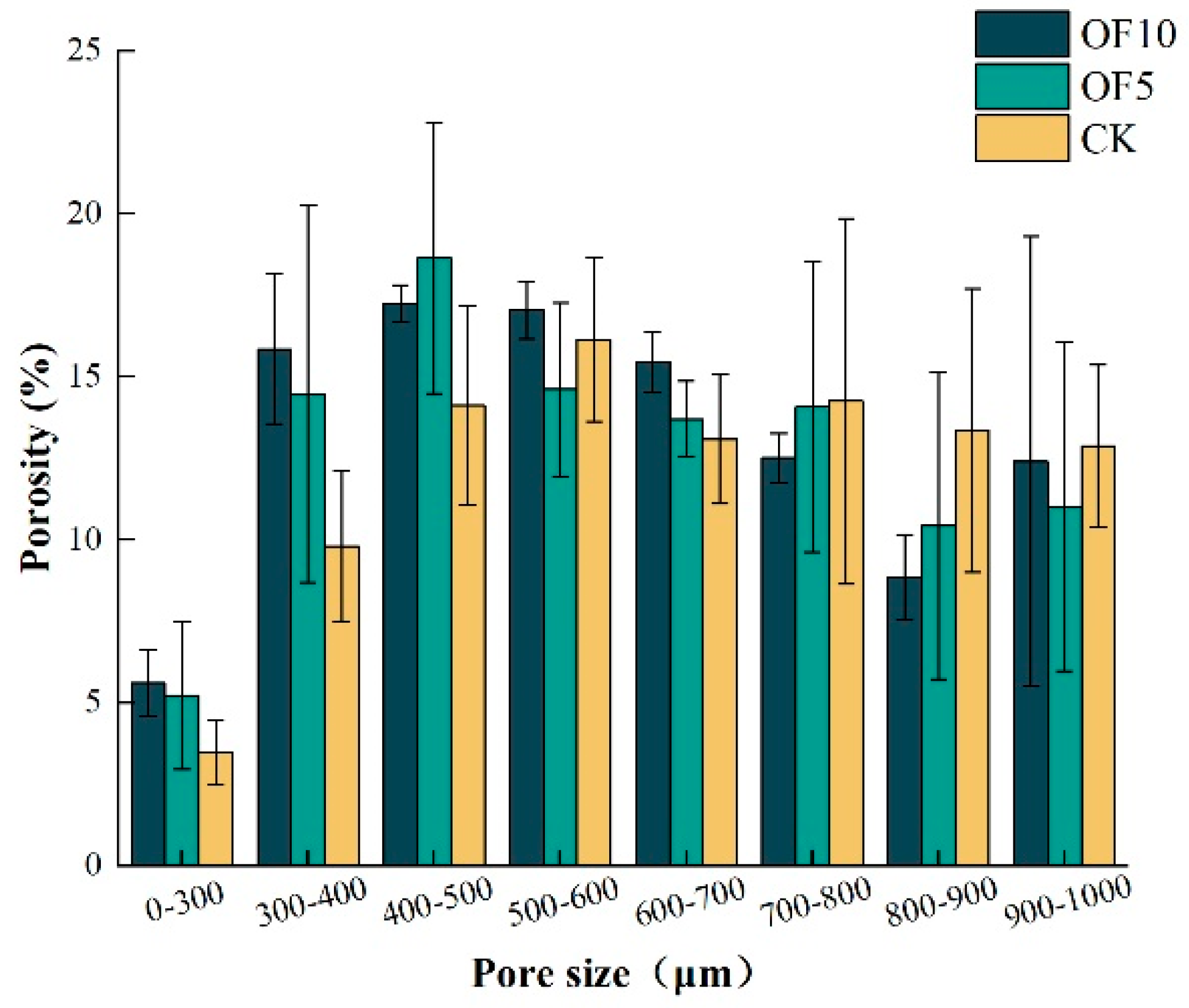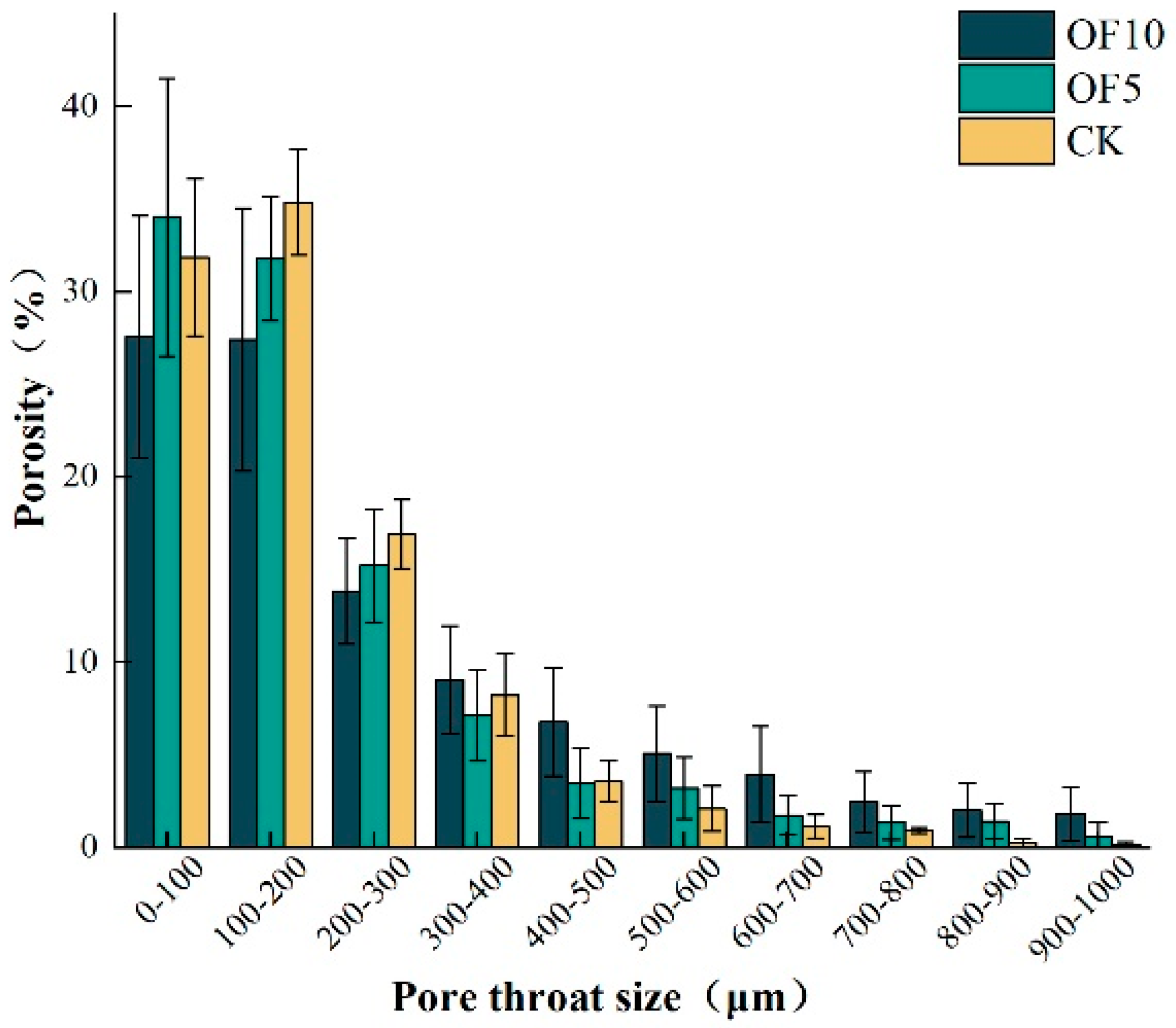Long-Term Application of an Oil Residue Organic Fertilizer Improved Soil Physical Properties in the Root Zone of Jujube Trees
Abstract
1. Introduction
2. Materials and Methods
2.1. Experimental Area
2.2. Soil Collection and Physical and Chemical Property Testing
2.3. Image Scanning and Processing
2.4. Data Processing and Analysis
3. Results
3.1. Changes in Soil Physical and Chemical Properties with Time
3.2. Quantifying Pore Morphology Following Fertilizer Application
3.3. Correlating Soil Physical and Chemical Properties with Soil Aggregate and Pore Structure Parameters
3.4. Effects of Fertilizer Use on Connected Pore Size Distribution
4. Discussion
4.1. Response of Soil to Long-Term Application of Organic Fertilizer
4.2. Effect of Organic Fertilizers on Soil Connectivity Pore Space
5. Conclusions
Author Contributions
Funding
Data Availability Statement
Conflicts of Interest
References
- Xiang, X.; Liu, J.; Zhang, J.; Li, D.; Xu, C.; Kuzyakov, Y. Divergence in fungal abundance and community structure between soils under long-term mineral and organic fertilization. Soil Tillage Res. 2020, 196, 104491. [Google Scholar] [CrossRef]
- Zhu, J.; Peng, H.; Ji, X.; Li, C.; Li, S. Effects of reduced inorganic fertilization and rice straw recovery on soil enzyme activities and bacterial community in double-rice paddy soils. Eur. J. Soil. Biol. 2019, 94, 103116. [Google Scholar] [CrossRef]
- Guo, K.; Zhao, Y.; Liu, Y.; Chen, J.; Wu, Q.; Ruan, Y.; Li, S.; Shi, J.; Zhao, L.; Sun, X.; et al. Pyrolysis temperature of biochar affects ecoenzymatic stoichiometry and microbial nutrient-use efficiency in a bamboo forest soil. Geoderma 2020, 363, 114162. [Google Scholar] [CrossRef]
- Paul, B.K.; Vanlauwe, B.; Ayuke, F.; Gassner, A.; Hoogmoed, M.; Hurisso, T.T.; Koala, S.; Lelei, D.; Ndabamenye, T.; Six, J.; et al. Medium-term impact of tillage and residue management on soil aggregate stability, soil carbon and crop productivity. Agric. Ecosyst. Environ. 2013, 164, 14–22. [Google Scholar] [CrossRef]
- Rab, M.A.; Haling, R.E.; Aarons, S.R.; Mannah, M.; Young, I.M.; Gibson, D. Evaluation of X-ray computed tomography for quantifying macroporosity of loamy pasture soils. Geoderma 2014, 213, 460–470. [Google Scholar] [CrossRef]
- Kim, C.; Devegowda, D. Molecular dynamics study of fluid-fluid and solid-fluid interactions in mixed-wet shale pores. Fuel 2022, 319, 123587. [Google Scholar] [CrossRef]
- Lu, S.; Yu, X.; Zong, Y. Nano-microscale porosity and pore size distribution in aggregates of paddy soil as affected by long-term mineral and organic fertilization under rice-wheat cropping system. Soil Tillage Res. 2019, 186, 191–199. [Google Scholar] [CrossRef]
- Ananyeva, K.; Wang, W.; Smucker, A.; Rivers, M.L.; Kravchenko, A.N. Can intra-aggregate pore structures affect the aggregate’s effectiveness in protecting carbon? Soil Biol. Biochem. 2013, 57, 868–875. [Google Scholar] [CrossRef]
- Yudina, A.; Kuzyakov, Y. Dual nature of soil structure: The unity of aggregates and pores. Geoderma 2023, 434, 116478. [Google Scholar] [CrossRef]
- Fei, C.; Dong, Y.Q.; An, S.Z. Factors driving the biomass and species richness of desert plants in northern Xinjiang China. PLoS ONE 2022, 17, e0271575. [Google Scholar] [CrossRef]
- Xu, L.Y.; Wang, M.Y.; Shi, X.Z.; Yu, Q.B.; Shi, Y.J.; Xu, S.X.; Sun, W.X. Effect of long-term organic fertilization on the soil pore characteristics of greenhouse vegetable fields converted from rice-wheat rotation fields. Sci. Total Environ. 2018, 631, 1243–1250. [Google Scholar] [CrossRef] [PubMed]
- Wang, W.; Zhang, Y.; Li, H. Quantification of soil structure via synchrotron X-ray tomography after 22 years of fertilization. Eur. J. Soil Sci. 2021, 72, 2115–2127. [Google Scholar] [CrossRef]
- Dal Ferro, N.; Charrier, P.; Morari, F. Dual-scale micro-CT assessment of soil structure in a long-term fertilization experiment. Geoderma 2013, 204, 84–93. [Google Scholar] [CrossRef]
- Koestel, J.; Larsbo, M.; Jarvis, N. Scale and REV analyses for porosity and pore connectivity measures in undisturbed soil. Geoderma 2020, 366, 114206. [Google Scholar] [CrossRef]
- Kan, X.; Zheng, W.; Cheng, J.; Zhangzhong, L.; Li, J.; Liu, B.; Zhang, X. Investigating Soil Pore Network Connectivity in Varied Vegetation Types Using X-ray Tomography. Water 2023, 15, 3823. [Google Scholar] [CrossRef]
- Mancer, H.; Rouahna, H.; Souici, S.; Otmani, Z.; Bettiche, F.; Menasria, H.; Rechachi, M.Z.; Chaib, W.; Mostephaoui, T. Effects of mineral and organic fertilization on potato production in sandy soil in arid region. Sci. Afr. 2024, 23, e2112. [Google Scholar] [CrossRef]
- Xu, Y.; Liu, X.; Yan, L.; Huang, X.; Wang, J. The addition of organic fertilizer can reduce the dependence of dryland yield on rainfall-based on a 32-year long-term study. Sci. Total Environ. 2024, 915, 170152. [Google Scholar] [CrossRef]
- Zhang, F.; Shen, J.; Zhang, J.; Zuo, Y.; Li, L.; Chen, X. Rhizosphere processes and management for improving nutrient use efficiency and crop productivity: Implications for China. Adv. Agron. 2010, 107, 1–32. [Google Scholar] [CrossRef]
- Li, S.; Sheng, M.; Yuan, F.; Yin, J. Effect of land cover change on total SOC and soil PhytOC accumulation in the karst subtropical forest ecosystem, SW China. J. Soils Sediments 2021, 21, 2566–2577. [Google Scholar] [CrossRef]
- Luan, H.; Gao, W.; Huang, S.; Tang, J.; Li, M.; Zhang, H.; Chen, X.; Masiliūnas, D. Organic amendment increases soil respiration in a greenhouse vegetable production system through decreasing soil organic carbon recalcitrance and increasing carbon-degrading microbial activity. J. Soils Sediments 2020, 20, 2877–2892. [Google Scholar] [CrossRef]
- Xiao, L.; Huang, Y.; Zeng, Q.; Zhao, J.; Zhou, J. Soil enzyme activities and microbial biomass response to crop types on the terraces of the Loess Plateau, China. J. Soils Sediments 2018, 18, 1971–1980. [Google Scholar] [CrossRef]
- Li, Q.; Zhang, D.; Cheng, H.; Ren, L.; Jin, X.; Fang, W.; Yan, D.; Li, Y.; Wang, Q.; Cao, A. Organic fertilizers activate soil enzyme activities and promote the recovery of soil beneficial microorganisms after dazomet fumigation. J. Environ. Manag. 2022, 309, 114666. [Google Scholar] [CrossRef] [PubMed]
- Błońska, E.; Piaszczyk, W.; Staszel, K.; Lasota, J. Enzymatic activity of soils and soil organic matter stabilization as an effect of components released from the decomposition of litter. Appl. Soil Ecol. 2021, 157, 103723. [Google Scholar] [CrossRef]
- Rietz, D.N.; Haynes, R.J. Effects of irrigation-induced salinity and sodicity on soil microbial activity. Soil Biol. Biochem. 2003, 35, 845–854. [Google Scholar] [CrossRef]
- Xie, W.; Zhang, Y.; Li, J.; Wei, S.; Li, X.; Yu, H.; Guan, B. Straw application coupled with N and P supply enhanced microbial biomass, enzymatic activity, and carbon use efficiency in saline soil. Appl. Soil Ecol. 2021, 168, 104128. [Google Scholar] [CrossRef]
- Ren, J.; Liu, X.; Yang, W.; Yang, X.; Li, W.; Xia, Q.; Li, J.; Gao, Z.; Yang, Z. Rhizosphere soil properties, microbial community, and enzyme activities: Short-term responses to partial substitution of chemical fertilizer with organic manure. J. Environ. Manag. 2021, 299, 113650. [Google Scholar] [CrossRef]
- Elliott, E. Aggregate structure and carbon, nitrogen, and phosphorus in native and cultivated soils. Soil Sci. Soc. Am. J. 1986, 50, 627–633. [Google Scholar] [CrossRef]
- Zuo, F.; Li, X.; Yang, X.; Wang, Y.; Ma, Y.; Huang, Y.; Wei, C. Soil particle-size distribution and aggregate stability of new reconstructed purple soil affected by soil erosion in overland flow. J. Soils Sediments 2020, 20, 272–283. [Google Scholar] [CrossRef]
- Nottingham, A.T.; Griffiths, H.; Chamberlain, P.M.; Stott, A.W.; Tanner, E.J. Soil priming by sugar and leaf-litter substrates: A link to microbial groups. Appl. Soil Ecol. 2009, 42, 183–190. [Google Scholar] [CrossRef]
- Xie, W.; Shao, P.; Zhang, Y.; Wei, S.; Li, J.; Sun, Y.; Zhang, H. Saline soil organic matter characteristics of aggregate size fractions after amelioration through straw and nitrogen addition. Land. Degrad. Dev. 2023, 34, 2098–2109. [Google Scholar] [CrossRef]
- Xiang, J.; Shi, W.; Jing, Z.; Guan, Y.; Yang, F.; Wang, G.; Sun, X.; Li, J.; Li, Q.; Zhang, H. Exogenous calcium-induced carbonate formation to increase carbon sequestration in coastal saline-alkali soil. Sci. Total Environ. 2024, 946, 174338. [Google Scholar] [CrossRef] [PubMed]
- Zhou, H.; Fang, H.; Mooney, S.J.; Peng, X. Effects of long-term inorganic and organic fertilizations on the soil micro and macro structures of rice paddies. Geoderma 2016, 266, 66–74. [Google Scholar] [CrossRef]
- Naveed, M.; Moldrup, P.; Vogel, H.; Lamandé, M.; Wildenschild, D.; Tuller, M.; Jonge L., W. Impact of long-term fertilization practice on soil structure evolution. Geoderma 2014, 217, 181–189. [Google Scholar] [CrossRef]
- Sandin, M.; Koestel, J.; Jarvis, N.; Larsbo, M. Post-tillage evolution of structural pore space and saturated and near-saturated hydraulic conductivity in a clay loam soil. Soil Tillage Res. 2017, 165, 161–168. [Google Scholar] [CrossRef]
- Paradelo, M.; Katuwal, S.; Moldrup, P.; Norgaard, T.; Herath, L.; Jonge, L.W. X-ray CT-derived soil characteristics explain varying air, water, and solute transport properties across a loamy field. Vadose Zone J. 2016, 15, 1–13. [Google Scholar] [CrossRef]
- Rabot, E.; Lacoste, M.; Hénault, C.; Cousin. Using X-ray computed tomography to describe the dynamics of nitrous oxide emissions during soil drying. Vadose Zone J. 2015, 14, 1–10. [Google Scholar] [CrossRef]
- Kravchenko, A.N.; Guber, A.K. Soil pores and their contributions to soil carbon processes. Geoderma 2017, 287, 31–39. [Google Scholar] [CrossRef]
- Pagliai, M.; Vignozzi, N.; Pellegrini, S. Soil structure and the effect of management practices. Soil Tillage Res. 2004, 79, 131–143. [Google Scholar] [CrossRef]
- Kandra, B.; Tall, A.; Vitková, J.; Procházka, M.; Šurda, P. Effect of Humic Amendment on Selected Hydrophysical Properties of Sandy and Clayey Soils. Water 2024, 16, 1338. [Google Scholar] [CrossRef]
- Prifling, B.; Weber, M.; Ray, N.; Prechtel, A.; Phalempin, M.; Schlüter, S.; Vetterlein, D.; Schmidt, V. Quantifying the impact of 3D pore space morphology on soil gas diffusion in loam and sand. Transp. Porous Med. 2023, 149, 501–527. [Google Scholar] [CrossRef]
- Regelink, I.C.; Stoof, C.R.; Rousseva, S.; Weng, L.; Lair, G.J.; Kram, P.; Nikolaidis, N.P.; Kercheva, M.; Banwart, S.; Comans, R.N. Linkages between aggregate formation, porosity and soil chemical properties. Geoderma 2015, 247, 24–37. [Google Scholar] [CrossRef]
- Pagliai, M.; De Nobili, M. Relationships between soil porosity, root development and soil enzyme activity in cultivated soils. In Soil Structure/Soil Biota Interrelationships; Elsevier: Amsterdam, The Netherlands, 1993; pp. 243–256. [Google Scholar] [CrossRef]






| Parameter | OF10 | OF5 | CK |
|---|---|---|---|
| BD (g·cm−3) | 1.37 b | 1.40 ab | 1.41 a |
| EC (μs·cm−1) | 118.17 c | 166.04 b | 191.73 a |
| OM (g·kg−1) | 9.52 a | 7.69 a | 7.58 a |
| INV (mg·g−1·d−1) | 3.96 a | 3.37 b | 3.01 b |
| URE (mg·g−1·d−1) | 1065.26 a | 850.47 a | 782.39 a |
| Parameter | OF10 | OF5 | CK |
|---|---|---|---|
| >2 mm (%) | 2.66 a | 2.83 a | 2.67 a |
| 2–0.25 mm (%) | 34.49 a | 26.95 ab | 22.64 b |
| <0.25 mm (%) | 62.85 b | 70.22 ab | 74.69 a |
| MWD (mm) | 0.52 a | 0.45 ab | 0.40 b |
| Pore Properties | OF10 | OF5 | CK |
|---|---|---|---|
| Total porosity (%) | 15.51 a | 9.44 b | 8.62 b |
| Total connectivity (%) | 83.02 a | 63.07 a | 61.60 a |
| Fractal dimension | 2.62 a | 2.60 b | 2.57 b |
| Average pore number | 589.00 a | 448.33 a | 405.00 a |
| Average pore throat number | 1880.67 a | 1064.33 a | 652.33 a |
| Average pore throat length (μm) | 2975.32 b | 3539.43 a | 3926.04 a |
| Soil Core Properties | BD | EC | OM | INV | URE |
|---|---|---|---|---|---|
| >2 mm (%) | −0.051 | 0.009 | −0.251 | −0.410 | 0.001 |
| 2–0.25 mm (%) | −0.803 | −0.732 | 0.986 ** | 0.977 ** | 0.951 ** |
| <0.25 mm (%) | 0.827 * | 0.748 | −0.980 ** | 0.952 ** | 0.973 ** |
| MWD (mm) | −0.826 * | −0.727 | 0.970 ** | 0.924 ** | 0.984 ** |
| Total porosity (%) | −0.922 ** | −0.825 * | 0.952 ** | 0.949 ** | 0.935 ** |
| Total connectivity (%) | −0.876 * | −0.729 | 0.853 * | 0.876 * | 0.764 |
| Fractal dimension | −0.905 * | −0.816 * | 0.877 * | 0.875 * | 0.901 * |
| Pore number | −0.610 | −0.518 | 0.108 | 0.103 | 0.168 |
| Average throat number | −0.713 | −0.582 | 0.833 * | 0.717 | 0.875 * |
| Average channel length (μm) | 0.801 | 0.908 * | −0.596 | −0.628 | −0.572 |
Disclaimer/Publisher’s Note: The statements, opinions and data contained in all publications are solely those of the individual author(s) and contributor(s) and not of MDPI and/or the editor(s). MDPI and/or the editor(s) disclaim responsibility for any injury to people or property resulting from any ideas, methods, instructions or products referred to in the content. |
© 2024 by the authors. Licensee MDPI, Basel, Switzerland. This article is an open access article distributed under the terms and conditions of the Creative Commons Attribution (CC BY) license (https://creativecommons.org/licenses/by/4.0/).
Share and Cite
Zhang, H.; Zhou, S.; Huang, W.; Zhu, Z.; Li, K.; Sun, S. Long-Term Application of an Oil Residue Organic Fertilizer Improved Soil Physical Properties in the Root Zone of Jujube Trees. Agronomy 2024, 14, 2964. https://doi.org/10.3390/agronomy14122964
Zhang H, Zhou S, Huang W, Zhu Z, Li K, Sun S. Long-Term Application of an Oil Residue Organic Fertilizer Improved Soil Physical Properties in the Root Zone of Jujube Trees. Agronomy. 2024; 14(12):2964. https://doi.org/10.3390/agronomy14122964
Chicago/Turabian StyleZhang, Huadong, Shaoliang Zhou, Weixiong Huang, Zhu Zhu, Kaixuan Li, and Sanmin Sun. 2024. "Long-Term Application of an Oil Residue Organic Fertilizer Improved Soil Physical Properties in the Root Zone of Jujube Trees" Agronomy 14, no. 12: 2964. https://doi.org/10.3390/agronomy14122964
APA StyleZhang, H., Zhou, S., Huang, W., Zhu, Z., Li, K., & Sun, S. (2024). Long-Term Application of an Oil Residue Organic Fertilizer Improved Soil Physical Properties in the Root Zone of Jujube Trees. Agronomy, 14(12), 2964. https://doi.org/10.3390/agronomy14122964






